Discussion
審査講評(5)
Comments on Honorable Mention winners
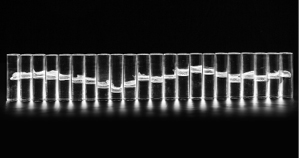
Calm
H30×W190×D10
2016
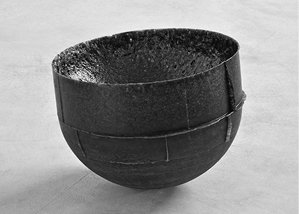
Structural Blue
H37.5×W45.5×D45
2016
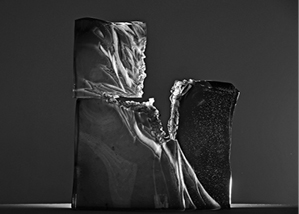
Page in History
H57×W45×D18
2016
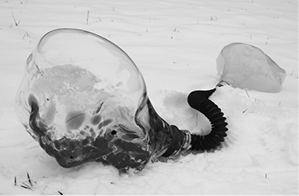
Chernobyl - Fukushima
H25×W60×D32
2015
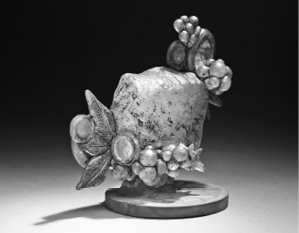
Echo from the Highland
H15×W12×D10
2016
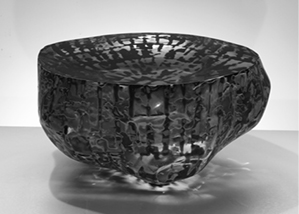
泉 3099
Fountain 3099
H26.8×W51×D51
2015
Takeda ───── Next we would like to introduce the six Honorable Mention winners. First, Mio Kosaka’s work titled ‘Calm’. I would like Mr Carlson to comment.
Carlson ───── Kosaka Mio, his work is the first one of the group of awardees that comes from the hot furnace. Other people have used heat and other people have used ovens and slumping and fusing, but this is the first one comes out of the furnace.
And indeed it is a powerful work.
It is powerful because of the number of the segments and it is also powerful in its metaphoric meaning.
So when an artist uses a sequence and repetition, there is always a reason and his reason.
He takes great consideration in the subtlety of repetition. And it becomes a visual thing.
It is like a science lab where different things are being distilled.
It is like a musical score where we are listening to something that is quite calming, which is the title of the piece.
Or maybe some melody in different kinds of chimes.
So the piece is quite powerful in its sculptural integrity, and next to a brick wall it’s not so wonderful.
It does not maximize the beauty and the power of the image.
But when it is installed in the exhibition, I am sure that it will be quite spectacular and quite interactive, making the viewer the kinetic part of the piece as they examine its variations.
The one other metaphorical or possible interpretation is that this is actually registering the rise and fall of yen next to the dollar.
As you look at the newspaper segments and newspaper charts, they will tell you about the subtle changes in the stock price for the monetary exchange rate.
Takeda ───── This work is quite large. When all the cylinders are assembled, the width is almost 2m. Second, Yoshiaki Kojiro’s ‘Structural Blue’. I would like Mr Zoritchak to comment.
Zoritchak ───── Kojiro Yoshiaki’s work is an experimental work. The work represents the thickness of time and its memory of the earth and human.
Takeda ───── We have been introducing many Japanese artists. All the jurors have agreed that quite a few Japanese artists’ works excel among all the submitted works. Third, ‘Page in History’ by Anda Munkevica from Latvia. I would like Mr Zoritchak to comment.
Zoritchak ───── I am happy to find this work applied from Latvia. The work expresses the flat landscape with its seasons and memory of the past events.
Takeda ───── Fourth, ‘Chernobyl - Fukushima’. I would like Ms Laursen to comment.
Laursen ───── This moving artwork comes from Belarus near Russia, and near Ukraine.
The title of the work by Pavel Voinitski is “Chernobyl-Fukushima” and it reminds us painfully of the disasters that happened in the world around us that tears apart the lives of innocent people and leaves them with terrible memories and scars for the rest of their lives.
In slow blowing glass and mixed technique, the work by Pavel Voinitski shows us a bleeding head of a women, connected with a gas filled bubble through a breathing tube.
The work reminds us that glass can be a medium for expressing not only aesthetics and skill but human and political statements of life and death.
It is important that a sculpture glass can remind us of danger, pain, sorrow and anger.
In a way, that keeps glass as a material. It keeps it alive and important as a means for expressing human feelings.
It is important that glass is used also in expressions like this.
Takeda ───── The fifth work is ‘Echo from the Highland’ by Meng Du from the United States. I would like Mr Carlson to comment.
Carlson ───── This piece by Du Meng is quite interesting. So, we pick out things in our lives and we collect them. Sometimes we collect them as kids, and sometimes as adults, and sometimes because we think that they are valuable.
Sometimes you just put your things in your pocket and you take them home for no good reason.
But there probably is a reason. Somehow they have caught you for the moment or they got in your way and you put them in your pocket or maybe you don’t know how they got there.
These ten components, twelve components, kind of represent that.
That little piece of rocky that are on vacation, that little coin you have stolen from your big brother, or a few pearls came off from the necklace from your good friend or maybe it’s something else. That maybe grew somewhere and then was just kind of blown around your backyard. But they are collection of things in a kind of a wonderful way, a kind of poetic.
In a way, a short story is a collection of words whatever the language might be, and poetry is a collection of things that make poetic sense. For me, these pieces bring in that narrative, that sense of story telling, and it’s maybe explicit and obvious for me they are more wonderfully abstract.
Your assignment is to start putting things in your pockets and putting them together for your artwork.
Takeda ───── Lastly, I would like Jun Fujita to comment on ‘Fountain 3099’ by Akihiro Isogai from Japan.
Fujita ───── I think that in the audience there are many people involved in the Japanese glass field who know Isogai’s name and his works well. His work received the Silver Prize at the International Exhibition of Glass Kanazawa 2013. This time he submitted a work, a fused glass lump, created with the same techniques as before. It weighs almost 100kg. The color of this year’s work is blue with harmonizing colored patterns on the exterior.
Isogai has continued his series of ‘Fountain’ for many years. He is now one of the old hands in his line. Still he always attempts to create something new. I empathize with his attitude to keep seeking novel ideas without changing his policy. Other jurors agreed with my opinion. What has made me feel refreshed is that he created the fountain with new colors and a stimulating effect.

